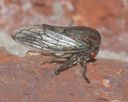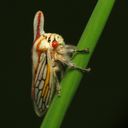Oak Treehopper
Platycotis vittata
Classification
- Phylum: Arthropoda
- Subphylum: Hexapoda
- Class: Insecta
- Order: Hemiptera
- Suborder: Auchenorrhyncha
- Infraorder: Cicadomorpha
- Superfamily: Membracoidea
- Family: Membracidae
- Subfamily: Membracinae
- Tribe: Hoplophorionini
- Genus: Platycotis
- Species: vittata
Pronunciation
How to pronounce Platycotis vittata: //ˌplæ.tɪˈkoʊ.tɪs vɪˈtɑː.tə//
These audio files are automatically generated. While they are not always 100% accurate, they are a good starting point.
Images






Summary
Platycotis vittata, the oak treehopper, is a species of treehopper in the family Membracidae, found primarily in North America, where it exhibits parental care by protecting its nymphs. It has distinct physical characteristics including a variable pronotal horn and is commonly associated with oak trees.
Physical Characteristics
♀ 9-13 mm, ♂ 9-12 mm; grayish spotted with yellow, or turquoise with red stripes and red eyes; may possess a long compressed pronotal horn that varies in length, or may be hornless; wing venation shows considerable variation.
Identification Tips
Easily distinguished by very short posterior tarsi. Variants can be horned or hornless.
Habitat
Forests and forest edges, parks, and areas where oak trees (Quercus spp.) are found; occasionally found on other trees.
Distribution
Mostly found in the eastern United States, British Columbia down to southern California, with limited records in Arizona and New Mexico; also found in Mexico.
Diet
Nymphs do almost no damage to host trees, primarily leaving twig scars from oviposition.
Life Cycle
Hatching occurs in Spring in the South and late Spring in the North; larvae pass through five instars; adults and larvae form aggregations along oak twigs that can number up to 100 individuals.
Reproduction
Females exhibit protective behavior, keeping predators away from their young.
Ecosystem Role
Oak specialist; contributes to the ecosystem by utilizing oak trees as a host.
Similar Taxa
- Umbonia
- Lephopelta
Tags
- Platycotis vittata
- oak treehopper
- Membracidae
- North America
- parental care